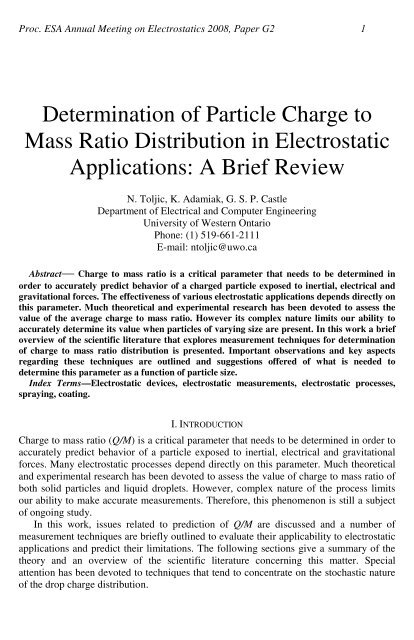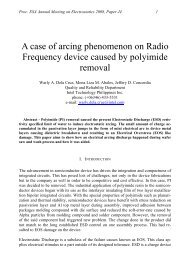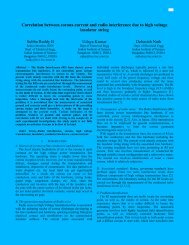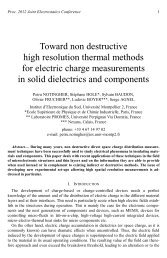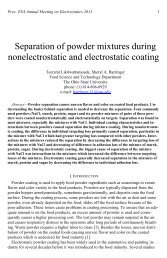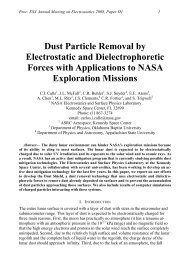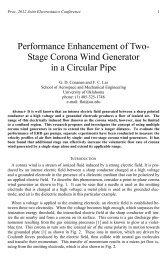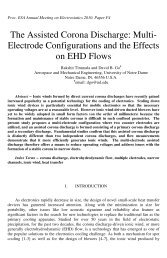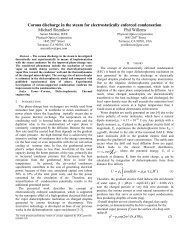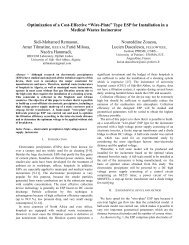Determination of Particle Charge to Mass Ratio Distribution in ...
Determination of Particle Charge to Mass Ratio Distribution in ...
Determination of Particle Charge to Mass Ratio Distribution in ...
You also want an ePaper? Increase the reach of your titles
YUMPU automatically turns print PDFs into web optimized ePapers that Google loves.
Proc. ESA Annual Meet<strong>in</strong>g on Electrostatics 2008, Paper G2 4Jones and Thong [6] discussed the electrical dispersion <strong>of</strong> a jet <strong>of</strong> kerosene <strong>in</strong><strong>to</strong> a spray<strong>of</strong> monodisperse droplets. Pressurized air was used <strong>to</strong> force the liquid from the reservoirthrough a f<strong>in</strong>e sta<strong>in</strong>less steel capillary <strong>to</strong> which a high voltage is applied. This generated aconical spray <strong>of</strong> f<strong>in</strong>e droplets which were deposited on the grounded plate. The flowsystem was designed <strong>to</strong> form a steady flow. The Q/M ratio was calculated as a ratio <strong>of</strong><strong>to</strong>tal current measured at the plate and <strong>to</strong>tal liquid flow. This Q/M ratio was found <strong>to</strong> be<strong>in</strong>versely proportional <strong>to</strong> the radius, and size <strong>of</strong> the particles ranged from 40m <strong>to</strong>120m. This agrees well with the surface area theory.Tang and Gomez [7] performed an experimental <strong>in</strong>vestigation on the feasibility <strong>of</strong>us<strong>in</strong>g an electrospray <strong>to</strong> produce monodisperse droplets <strong>of</strong> water <strong>in</strong> the diameter range 2-10m. Because <strong>of</strong> the high surface tension <strong>of</strong> water, the establishment <strong>of</strong> stable spraysrequired the use <strong>of</strong> a sheet flow <strong>of</strong> carbon dioxide <strong>to</strong> prevent breakdown <strong>in</strong> the gassurround<strong>in</strong>g the spray and its destabiliz<strong>in</strong>g consequences on the electrosprayperformance. The experimental setup consisted <strong>of</strong> a sta<strong>in</strong>less steel capillary charged at ahigh electric potential, and a grounded electrode positioned perpendicularly <strong>to</strong> thecapillary. The droplet charge level was determ<strong>in</strong>ed by measur<strong>in</strong>g the <strong>to</strong>tal currentcollected by the ground electrode. S<strong>in</strong>ce an electrospray operat<strong>in</strong>g <strong>in</strong> cone-jet modegenerates a very narrow size distribution, the volume charge density <strong>of</strong> the electrospraywas well represented by a mean value calculated from the ratio between the <strong>to</strong>tal electriccurrent and the <strong>to</strong>tal liquid flow rate. Authors concluded that the volume charge densityvaries with the <strong>in</strong>verse <strong>of</strong> the droplet diameter. This also agrees well with the surface areatheory.Ye and Domnick [8] presented a numerical method for the calculation <strong>of</strong> the electricfield with space charge <strong>in</strong> electrostatic powder coat<strong>in</strong>g with a corona spray gun and useda suction-type Faraday cup apparatus <strong>to</strong> measure the Q/M ratio. The suction tube with adiameter <strong>of</strong> 10 mm was mounted <strong>in</strong> the centre <strong>of</strong> the target. The spray gun could bemoved <strong>in</strong> a horizontal direction. <strong>Particle</strong>s with full size distribution were sprayed.Their calculated charge-<strong>to</strong>-mass pr<strong>of</strong>ile based on Pauthenier theory [9] showed a goodagreement with the experiment for the particle radius less than 60m. This is a goodagreement with surface area theory. For particles with larger diameter, the experimentalcharge-<strong>to</strong>-mass values stayed constant which differs from the theory. They concluded thatthis was probably due <strong>to</strong> the experimental uncerta<strong>in</strong>ty for the large particles. From theobta<strong>in</strong>ed results, it was evident that the sensitivity <strong>of</strong> this <strong>in</strong>strument decreased with<strong>in</strong>creas<strong>in</strong>g mean particle diameter.B. Dynamic MethodsJohns<strong>to</strong>n [10] described a semi au<strong>to</strong>matic method for determ<strong>in</strong>ation <strong>of</strong> the distribution <strong>of</strong>the magnitude and polarity <strong>of</strong> the charge on airborne dust. The aerosol is sampled throughan electrified electrode with the flow split perpendicular <strong>to</strong> the electric field direction.Flow rates through both exit parts need <strong>to</strong> be approximately the same. This is achieved byconnect<strong>in</strong>g one <strong>to</strong> a vacuum l<strong>in</strong>e and the other <strong>to</strong> an optical particle counter which countsthe numbers <strong>of</strong> particles <strong>in</strong> a selected size range. His plotted data shows l<strong>in</strong>eardependence <strong>of</strong> the particle charge on particle diameter. This implies that the Q/M ratio is<strong>in</strong>versely proportional <strong>to</strong> the square <strong>of</strong> radius. <strong>Particle</strong>s diameter was measured <strong>in</strong> therange between 0.5m and 8m.Gillespie and Langstroth [11] measured electric charges on the aerosol particles. Asheet <strong>of</strong> air drew the particles through a transverse electric field between two microscope
Proc. ESA Annual Meet<strong>in</strong>g on Electrostatics 2008, Paper G2 5slides. S<strong>in</strong>ce the charge and size <strong>of</strong> a particle determ<strong>in</strong>ed the distance <strong>of</strong> travel <strong>in</strong> thedirection <strong>of</strong> air flow before deposition on a slide, a microscopic assessment <strong>of</strong> the numberand sizes permitted calculation <strong>of</strong> the charge distribution. The relationship betweenparticle charge and particle radius was l<strong>in</strong>ear which <strong>in</strong>fers that Q/M was <strong>in</strong>verselyproportional <strong>to</strong> the square <strong>of</strong> radius. All the measured particles had a radius below 2m.Pfeifer and Hendricks [12] developed a relationship between droplet Q/M ratio anddroplet radius for electro hydrodynamically sprayed droplets. Probability distributions <strong>of</strong>the Q/M ratio and the droplet radius were derived as modified Maxwell-Boltzmannfunctions under the assumption that the unstable liquid mass disrupts <strong>in</strong><strong>to</strong> equally sizedand charged particles so that the system energy tends <strong>to</strong>ward a m<strong>in</strong>imum value. <strong>Particle</strong>Q/M ratio was found <strong>to</strong> be <strong>in</strong>versely proportional <strong>to</strong> the particle radius <strong>to</strong> the power <strong>of</strong>1.5. Experimental verification showed good agreement for oc<strong>to</strong>il and glycer<strong>in</strong>e andrelatively good agreement with Krohn’s data for Wood’s metal [13] where the radiusexponent was 1.7. In these data particle radii were between 0.5m and 10m.Juan et al. [14] <strong>in</strong>vestigated the distributions <strong>of</strong> charge and diameter <strong>of</strong> drops emittedfrom electrified liquid cones <strong>in</strong> the cone-jet mode. The liquid came from a reservoir athigh pressure through a sta<strong>in</strong>less steel needle which is charged <strong>to</strong> several kilovolts. TheTaylor cone produced at the tip <strong>of</strong> the needle generates a cloud <strong>of</strong> charged droplets <strong>in</strong>sidea sta<strong>in</strong>less steel chamber. Two <strong>of</strong> the oppos<strong>in</strong>g open<strong>in</strong>gs are sealed with glass w<strong>in</strong>dows <strong>in</strong>order <strong>to</strong> provide optical access. One open<strong>in</strong>g was for the microscope and the other for theillum<strong>in</strong>ation <strong>of</strong> the Taylor cone with a cont<strong>in</strong>uous light source. Fac<strong>in</strong>g the needle is thesampler. A differential mobility analyzer (DMA) first samples the spray drops, selectsthose whose electrical mobility is with<strong>in</strong> a narrow band, and either measures theassociated current or passes them <strong>to</strong> a second DMA <strong>in</strong>strument (aerosizer) through anorifice by pumps. When the current through the cone is measured, the spray chamber andthe sampl<strong>in</strong>g tube are connected directly <strong>to</strong> an electrometer. The current is moni<strong>to</strong>red atthe end <strong>of</strong> each run <strong>to</strong> ensure that the conditions rema<strong>in</strong> unchanged dur<strong>in</strong>g theexperiment. The mobility <strong>of</strong> the drops could be measured <strong>in</strong> the DMA. Droplet chargewas then uniquely determ<strong>in</strong>ed by measur<strong>in</strong>g droplet mobility and droplet diameter. For agiven cone-jet parameters, the distribution <strong>of</strong> charge for the ma<strong>in</strong> (primary) drops is 2.5times broader than the distribution <strong>of</strong> diameters, and ratio <strong>of</strong> maximum and m<strong>in</strong>imumcharge is 4. <strong>Particle</strong> diameters were <strong>in</strong> the range <strong>of</strong> 0.65m <strong>to</strong> 1.35m. It is stated that thecharge <strong>of</strong> a droplet is proportional <strong>to</strong> it’s diameter <strong>to</strong> the power <strong>of</strong> 3 which means that thecharge <strong>to</strong> mass ratio is not a function <strong>of</strong> particle diameter.Chen et al. [15] summarized the literature data on particle Q/M <strong>in</strong> gas-solids fluidizedbeds directly measured after steady state conditions have been reached. They showed thatthe experimental values were consistently lower than the maximum Q/M predicted byPaschen’s limit. They expla<strong>in</strong>ed that this was likely associated with low operat<strong>in</strong>g gasvelocities used <strong>in</strong> most experiments, which limited the build up <strong>of</strong> charge on particles, aswell as with the leakage <strong>of</strong> charges from the fluidized bed through the wall.Orme et al. [16] observed the formation <strong>of</strong> highly uniform charged molten metal dropsfrom a capillary stream. The conductive molten liquid was grounded and a positiveperiodic potential was applied <strong>to</strong> the charg<strong>in</strong>g electrode. Molten metal droplets werecharged by electrostatic <strong>in</strong>duction. The molten metal jet passed through the chargeelectrode that surrounded the jet at the po<strong>in</strong>t <strong>of</strong> droplet formation. As drops were formedfrom the cont<strong>in</strong>uous column <strong>of</strong> molten metal, a negative charge was <strong>in</strong>duced on the drop.
Proc. ESA Annual Meet<strong>in</strong>g on Electrostatics 2008, Paper G2 6<strong>Charge</strong>d droplets passed through the space between the deflection electrodes and weredeposited on the substrate. Q/M ratio <strong>of</strong> the droplets was determ<strong>in</strong>ed by measur<strong>in</strong>g thedeflection <strong>of</strong> the droplets trajec<strong>to</strong>ries. This ratio was <strong>in</strong>versely proportional <strong>to</strong> the square<strong>of</strong> radius. Size <strong>of</strong> the particles ranged from 375m <strong>to</strong> 400m. The authors showedexcellent agreement between their experimental values and Schneider’s theoreticalpredictions [17].Kulon, Malyan and Balachandran [18] used a non<strong>in</strong>vasive method <strong>of</strong> measurement <strong>of</strong>the charge level on a population <strong>of</strong> particles by comb<strong>in</strong><strong>in</strong>g the Phase DopplerAnemometry technique and high-resolution computer-controlled travers<strong>in</strong>g system.The Phase Doppler Anemometry technique is a non<strong>in</strong>trusive optical method forsimultaneous measurement <strong>of</strong> the size as well as the velocity <strong>of</strong> spherical particles. Thepr<strong>in</strong>ciple <strong>of</strong> the Phase Doppler Anemometry is based on light scatter<strong>in</strong>g from two-planelight beams <strong>in</strong>cident on the particle. Measurement region with<strong>in</strong> the spray is formed bythe <strong>in</strong>tersection <strong>of</strong> the laser beams. Each pair <strong>of</strong> beams is coherent and polarized so thatwhen they <strong>in</strong>tersect an <strong>in</strong>terference pattern <strong>of</strong> light and dark fr<strong>in</strong>ges is formed. The phaseshift between the signals from different detec<strong>to</strong>rs is proportional <strong>to</strong> the size <strong>of</strong> thespherical particle.The velocity measurement is based on the Doppler Effect. When two coherent andpolarized laser beams <strong>in</strong>tersect an <strong>in</strong>terference pattern <strong>of</strong> light and dark fr<strong>in</strong>ges is formed.As a droplet passes through the measurement region it scatters light at a frequency basedon its velocity normal <strong>to</strong> the fr<strong>in</strong>ges and the spac<strong>in</strong>g <strong>of</strong> the fr<strong>in</strong>ges. A receiv<strong>in</strong>g devicemeasures the frequency <strong>of</strong> this scatter<strong>in</strong>g signal and the spac<strong>in</strong>g <strong>of</strong> the fr<strong>in</strong>ges is knownbased on the wavelength <strong>of</strong> the laser light and the angle between the beams. Know<strong>in</strong>g theDoppler frequency, frequency <strong>of</strong> the scattered signal and the spac<strong>in</strong>g <strong>of</strong> the fr<strong>in</strong>ges, theparticle velocity can be calculated.The PDA system was used <strong>to</strong> track the motion <strong>of</strong> charged particles <strong>in</strong> air <strong>in</strong> thepresence <strong>of</strong> a dc electric field with<strong>in</strong> the space between the parallel-plate electrodes.<strong>Charge</strong>d particles exposed <strong>to</strong> the external electric field and situated <strong>in</strong> a viscousmedium experience two types <strong>of</strong> forces exerted on them: external electrical force anddrag force as a result <strong>of</strong> a relative motion <strong>of</strong> a particle <strong>in</strong> the air. After the relaxation time,a particle atta<strong>in</strong>s mechanical equilibrium and reaches a steady state velocity relative <strong>to</strong> themedium. By equat<strong>in</strong>g drag resistance force and the electrical force <strong>in</strong> the direction <strong>of</strong> theparticle drift velocity, know<strong>in</strong>g the size and motion parameters the charge on an<strong>in</strong>dividual particle can be calculated.It should be noted that space charge contribution <strong>to</strong> the overall electric field was notconsidered. The particle charge, as expected, was seen <strong>to</strong> <strong>in</strong>crease with <strong>in</strong>creas<strong>in</strong>g particlesize. Their experimental results showed that an average charge-<strong>to</strong>-mass ratio is 0.24C/g.Radius for all the particles was below 4m. <strong>Charge</strong> <strong>to</strong> mass ratio is <strong>in</strong>versely proportional<strong>to</strong> the square <strong>of</strong> radius. Radius exponent <strong>in</strong> this dependency is greater than expected.Gemci et al. [19] described an experimental setup <strong>to</strong> obta<strong>in</strong> the <strong>in</strong>dividual dropletcharge <strong>to</strong> mass ratio based on the measurements <strong>of</strong> the drop size and velocity by PhaseDoppler Interferometer. Drops were accelerated <strong>to</strong> term<strong>in</strong>al velocity <strong>in</strong> a known uniformelectric field after they had passed through a small hole <strong>in</strong> the deposition electrode. Thephase Doppler Interferometer system was positioned <strong>to</strong> measure sizes and velocities <strong>of</strong><strong>in</strong>dividual drops pass<strong>in</strong>g through the region beyond the grounded electrode.
Proc. ESA Annual Meet<strong>in</strong>g on Electrostatics 2008, Paper G2 7<strong>Particle</strong>s reach the equilibrium state and term<strong>in</strong>al velocity when electrical,gravitational and viscous drag force are <strong>in</strong> balance. Equat<strong>in</strong>g forces act<strong>in</strong>g upon a particleyields the particle charge. The charge <strong>to</strong> mass ratio <strong>of</strong> each <strong>in</strong>dividual drop is computed.The distribution <strong>of</strong> charge <strong>to</strong> mass ratios is well correlated with the Paschen chargelimit<strong>in</strong>g theory. A l<strong>in</strong>e that marks the upper limit <strong>of</strong> the distribution co<strong>in</strong>cides well withthe Paschen l<strong>in</strong>e and all drops <strong>in</strong> the measured distribution have charge <strong>to</strong> mass ratiosbelow but with<strong>in</strong> one order <strong>of</strong> magnitude <strong>of</strong> the Paschen maximum. It should be notedthat the space charge density effect on the overall electric field is not considered. <strong>Charge</strong><strong>to</strong> mass ratio is <strong>in</strong>versely proportional <strong>to</strong> the square <strong>of</strong> radius which means that the radiusexponent is greater than our assumed value.Mazumder et al. [20]-[21] applied a laser-beam <strong>in</strong>strument called the electrical-s<strong>in</strong>gleparticle aerodynamics relaxation time (E-SPART) analyzer for measur<strong>in</strong>g aerodynamicsize and electrostatic charge distribution <strong>of</strong> particles <strong>in</strong> real-time and on a s<strong>in</strong>gle particlebasis. Direct application <strong>of</strong> this was used <strong>to</strong> characterize <strong>to</strong>ner particles <strong>in</strong> electropho<strong>to</strong>graphy.As the particle passes through the sens<strong>in</strong>g volume located at the centre <strong>of</strong>the relaxation chamber <strong>in</strong> the direction normal <strong>to</strong> the plane conta<strong>in</strong><strong>in</strong>g two laser beams itexperiences acoustic excitations that cause particle oscillations. If the particle is chargedit experiences another velocity component due <strong>to</strong> the presence <strong>of</strong> dc field. From thevalues <strong>of</strong> phase lag and electrical migration velocity particle charge is calculated. Thema<strong>in</strong> disadvantage <strong>of</strong> this technique is limited time resolution. Average count rate isaround 100 particles per second. Size distribution ranged from 2m <strong>to</strong> 20m and charge<strong>to</strong>-massratio was below 20C/g. <strong>Charge</strong> <strong>to</strong> mass ratio is <strong>in</strong>versely proportional <strong>to</strong> thesquare <strong>of</strong> radius. Radius exponent is greater than expected value.Q/M ratio distribution measured by E-SPART at the downstream <strong>of</strong> the lung model[22] was, also, <strong>in</strong>versely proportional <strong>to</strong> the square <strong>of</strong> radius.Wong and Shrimp<strong>to</strong>n [23] determ<strong>in</strong>ed the electrical charge distribution amongst thedrops by post-process<strong>in</strong>g Phase Doppler Anemometry data for electrostatically a<strong>to</strong>mizedliquid sprays. Extend<strong>in</strong>g the technique <strong>of</strong> Schwar et al. [24], a method was developed <strong>of</strong>def<strong>in</strong><strong>in</strong>g mean and root mean square drop charge by post process<strong>in</strong>g method <strong>of</strong> dataobta<strong>in</strong>ed from Phase Doppler Anemometry measurements. Axial and radial velocities anddiameters <strong>of</strong> <strong>in</strong>dividual drops are available for a set <strong>of</strong> measurement locations.Reasonable assumptions were made <strong>in</strong> order <strong>to</strong> <strong>in</strong>vestigate the relationship betweenthe drop charge and the droplet diameter. It is assumed that droplet charge <strong>of</strong> the m th dropsize class varies with diameter such that:nqm= AD m(4)where qmis the drop charge <strong>of</strong> the m th drop size class, Dmis the diameter <strong>of</strong> the m thdrop size class,A is parameter constant for all the drops and n is real number constant for each drop sizeclass.By equaliz<strong>in</strong>g the radial components <strong>of</strong> the forces act<strong>in</strong>g on the droplet with the abovegiven assumption, one can graphically obta<strong>in</strong> values <strong>of</strong> the unknown parameter n for eachmeasured po<strong>in</strong>t. To obta<strong>in</strong> an estimate <strong>of</strong> A relative and actual volumetric spray specificcharges are compared. With obta<strong>in</strong>ed estimates for n for each data po<strong>in</strong>t and estimate for
Proc. ESA Annual Meet<strong>in</strong>g on Electrostatics 2008, Paper G2 8A for each data set, all drops are re processed for all measurement locations, for each dataset <strong>to</strong> f<strong>in</strong>d the mean and standard deviation <strong>of</strong> drop charge as a function <strong>of</strong> size.Follow<strong>in</strong>g this method, it is found that drop charge does not exceed Rayleigh limit fornearly all mean charges. As no explicit limit is imposed dur<strong>in</strong>g post process<strong>in</strong>g, thisconfirms the applicability <strong>of</strong> the proposed method.Processed data show that the values <strong>of</strong> the drop charge are proportional <strong>to</strong> dropletdiameter <strong>to</strong> the power <strong>of</strong> exponent which varies <strong>in</strong> range <strong>of</strong> 2.1 <strong>to</strong> 2.9 for the spray <strong>of</strong>specific charge 1.2C/m 3 . The lower limit <strong>of</strong> this range agrees well with surface areatheory and the upper limit with that <strong>of</strong> the results reported above [14].IV. CONCLUSIONIn this work a brief overview <strong>of</strong> scientific literature that explores measurement techniquesfor determ<strong>in</strong>ation <strong>of</strong> charge <strong>to</strong> mass ratio distribution <strong>in</strong> electrostatic applications ispresented. Important observations and key aspects regard<strong>in</strong>g these techniques are noted.It is shown that the conflict<strong>in</strong>g results exist for the dependence <strong>of</strong> charge <strong>to</strong> mass ratio onparticle size and it is suggested that this area needs further experimental and theoreticalresearch.REFERENCES[1] R. C. Brown, “Tu<strong>to</strong>rial review: Simultaneous measurement <strong>of</strong> particle size and particle charge,” J.Aerosol Sci., vol. 98, pp. 1373–1391, 1997.[2] A. Krupa and A. Jaworek, “A method for aerosol-particle charge measurements,” J. Electrostat., vol. 23,pp. 289–292, 1989.[3] J.R. Greaves and B. Mak<strong>in</strong>, “Measurement <strong>of</strong> the electric charge from aerosol cans” IAS AnnualMeet<strong>in</strong>g, C<strong>in</strong>c<strong>in</strong>nati, pp. 1075-1080., 1980.[4] D. C. Aldred, A. F. Howe and A. Wright, “Size selective particle charge measurement” Filtech Conf.,1983.[5] T.C. Anes<strong>to</strong>s, J.E. Sickles and R.M. Tepper, “<strong>Charge</strong> <strong>to</strong> mass distributions <strong>in</strong> electrostatic sprays,” IEEETrans. Ind. App., Vol.13 Mar./Apr. 1977, No.2, pp. 168-177.[6] Jones A. R., “The production <strong>of</strong> charged monodisperse fuel droplets by electrical dispersion” J. Phys. D:Appl. Phys. Vol. 4, pp. 1159-1166, 1971.[7] K. Tang and A. Gomez, “Generation by electrospray <strong>of</strong> monodisperse water droplets for targeted drugdelivery by <strong>in</strong>halation,” J. Aerosol Sci., pp. 1237–1249, 1994.[8] Q. Ye and J. Domnick, “On the simulation <strong>of</strong> space charge <strong>in</strong> electrostatic powder coat<strong>in</strong>g with a coronaspray gun,” Powder Technology, Vol. 135-136, pp.250-260, 2003[9] M.M. Pauthenier, M. Moreau-Hanot, “La <strong>Charge</strong> des Particules sphériques dans un champ ionize”, J. d’Physique Radium, 7, 590– 613, 1932.[10] A. M. Johns<strong>to</strong>n, “A semi-au<strong>to</strong>matic method for assessment <strong>of</strong> electric charge carried by airborne dust,” J.Aerosol Sci, vol. 14, no. 5, pp. 643–655, 1983.[11] T. Gillespie and G. O. Langstroth, “An <strong>in</strong>strument for determ<strong>in</strong><strong>in</strong>g the electric charge distribution <strong>in</strong>aerosol,” Can. J. Chem., vol. 30, pp. 1056–1068, 1952.[12] Pfeifer R.J., Hendricks C.D., “<strong>Charge</strong>-<strong>to</strong>-mass relationships for electrohydrodynamically sprayed liquiddroplets”, Phys Fluids, vol. 10, pp. 2149–2154, 1967.[13] V. E. Krohn, “Liquid Metal Droplets for Heavy <strong>Particle</strong> Propulsion,” Progr. In Astronautics andRocketry, A. C. N. Y., Vol. 5, 1961.[14] L. de Juan and J. F. de la Mora, “<strong>Charge</strong> and Size <strong>Distribution</strong>s <strong>of</strong> Electrospray Drops,” Journal <strong>of</strong>Colloid and Interface Science, 1997.[15] Chen, A., Bi, H.T. and Grace, J.R., "Measurement <strong>of</strong> particle charge-<strong>to</strong>-mass ratios <strong>in</strong> a gas-solidsfluidized bed by collision probe," Powder Technology, pp.135-181, 2003.[16] M. Orme, J. Courter, Q. Liu, J. Zhu, R. Smith "<strong>Charge</strong>d Molten Metal Droplet Deposition as a DirectWrite Technology," MRS 2000 Spr<strong>in</strong>g Meet<strong>in</strong>g, 2000.
Proc. ESA Annual Meet<strong>in</strong>g on Electrostatics 2008, Paper G2 9[17] Schneider J. M., L<strong>in</strong>dblad N. R., Hendricks C. D., “Stability <strong>of</strong> an Electrified Liquid Jet,” J. AppliedPhysics, vol. 38, issue 6, pp. 2599, 1967.[18] J. Kulon, B. E. Malyan and Wamadeva Balachandran, “Simultaneous measurement <strong>of</strong> particle size andelectrostatic charge distribution <strong>in</strong> DC electric field us<strong>in</strong>g phase Doppler anemometry”, IEEETransactions On Industry Applications, vol. 39, no. 5, 2003.[19] T. Gemci, R. Hitron and N. Chigier, “Measur<strong>in</strong>g <strong>Charge</strong>-To-<strong>Mass</strong> <strong>Ratio</strong> Of Individual Droplets Us<strong>in</strong>gPhase Doppler Interferometry,” ILASS Americas, May 2002.[20] M. K. Mazumder, R. E. Ware, T. Yokoyama, B. J. Rub<strong>in</strong>, and D. Kamp, “Measurement <strong>of</strong> particle sizeand electrostatic charge distributions on <strong>to</strong>ners us<strong>in</strong>g E-SPART analyzer,” IEEE Trans. Ind. Applicat,vol. 27, pp. 611–618, July/Aug. 1991.[21] M. K. Mazumder, S. Banerjee, R. E. Ware, C. Mu, N. Kay, and C. C. Huang, "Characterization <strong>of</strong>Tribocharg<strong>in</strong>g Properties <strong>of</strong> Powder Pa<strong>in</strong>t", IEEE/IAS Transactions, vol. 30, pp. 365-369, 1994.[22] D. Sa<strong>in</strong>i, C.U. Yurteri, N. Grable, R.A. Sims, and M.K. Mazumder, “Drug Delivery Studies onElectrostatically <strong>Charge</strong>d Dry Powder Inhaler Aerosols us<strong>in</strong>g a Glass Bead Lung Model”, Proceed<strong>in</strong>gs37th IEEE/IAS Annual Meet<strong>in</strong>g , Oc<strong>to</strong>ber 2002.[23] M. C. Y. Wong and J. S. Shrimp<strong>to</strong>n, “Drop-charge Correlations for Polydisperse ElectrostaticallyA<strong>to</strong>mized Liquid Sprays,” IEEE Transactions on Dielectrics and Electrical Insulation, vol. 11, part 2,2003.[24] M. J. R. Schwar, K. C. Thong and F. J. We<strong>in</strong>burg, ‘‘Measur<strong>in</strong>g the Mobility <strong>of</strong> <strong>Charge</strong>d Aerosols bySchlieren Interferometry <strong>of</strong> Doppler-Shifted Light’’, J. Phys D: Appl. Phys., Vol. 3, 1970.


